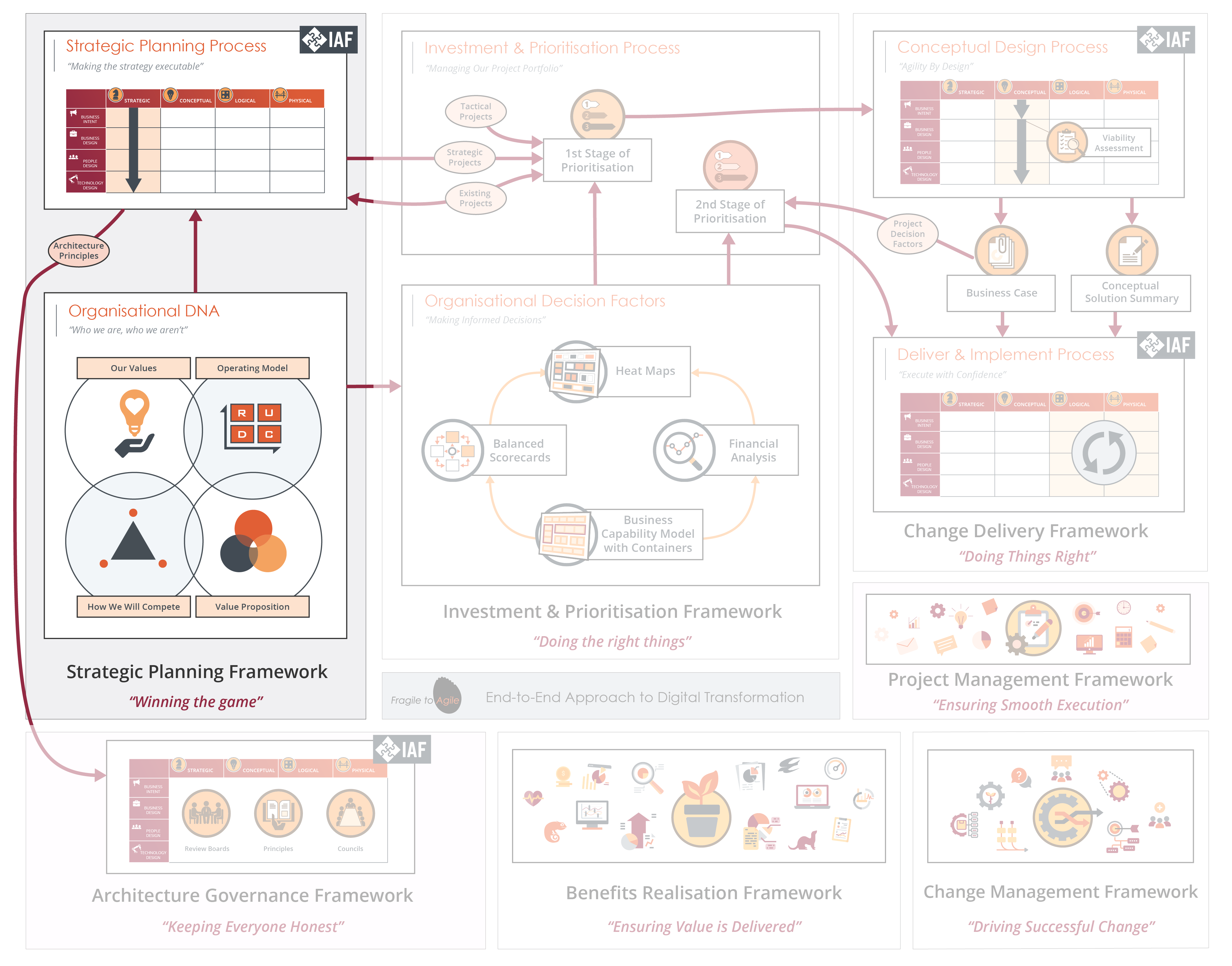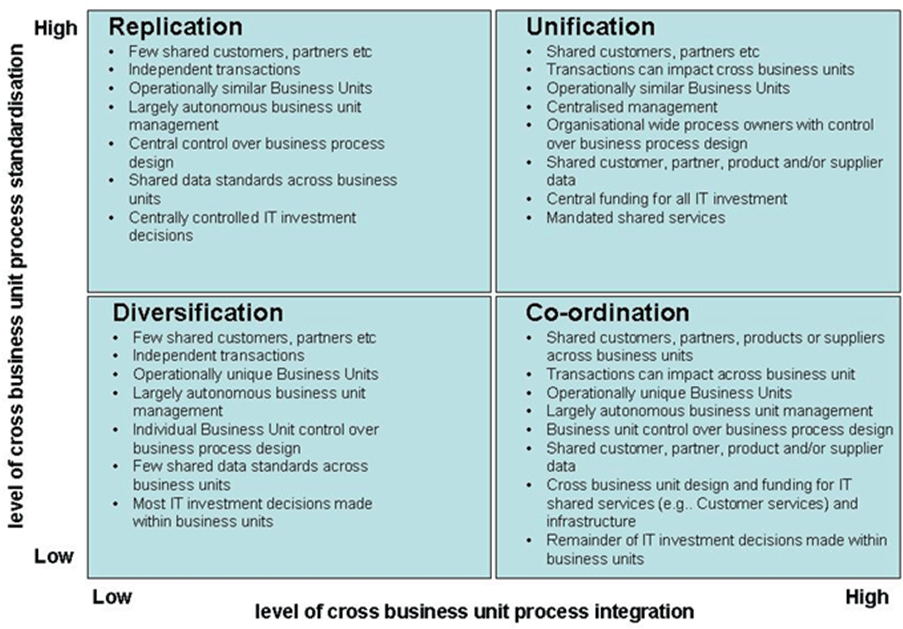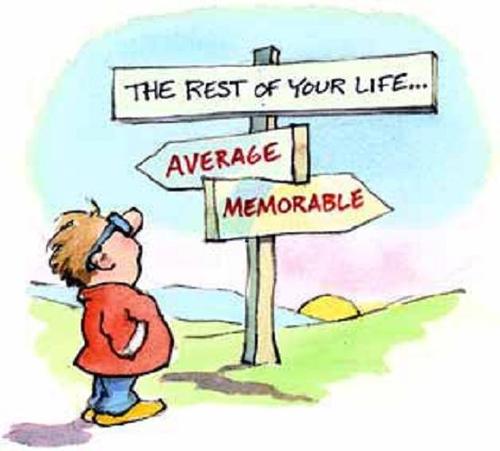Strategic Planning Framework “Winning the Game”
Firstly, Organisational DNA encapsulates an organisation’s corporate strategy, values, operating model and overall vision. For private sector organisations, this may include how it competes, its point of difference in the market and competitive landscape. For the public sector, this may include the department’s charter, its mission and vision and key stakeholders. The Organisational DNA tends to be quite stable and usually undergoes a revision when major changes occur within the organisation, such as merger and acquisition activity, or those externally imposed such as regulatory changes or global financial shocks. For example, Internet Service Providers had to revisit their core strategy and other elements of their DNA with the advent of the National Broadband Network.
The second part of Strategic Planning is how to actually execute the strategy, the period of an organisation’s strategic planning horizon, what outcomes are to be achieved and what is required to achieve them.
Strategic Planning Framework
The following diagram depicts, at a high level, our Strategic Planning Framework:

Organisational DNA – “Who we are, who we aren’t”
Fragile to Agile does not determine an organisation’s core strategy or Organisational DNA. We simply capture the key aspects of it that have a material impact on its Enterprise Architecture. If an organisation has not already determined the answers to the questions below we can help facilitate this conversation. Similarly, the sections below only discuss the elements that have a material impact on Enterprise Architecture and is not inclusive of all of the issues that an organisation needs to address as part of its strategy determination.

How We Will Compete
For an organisation’s Enterprise Architecture, it is important to understand how it will compete whether it is price, product or service or a combination of these elements. For an organisation with multiple business divisions, it is also important to understand whether they all compete on the same basis. For example, if an organisation is competing primarily on price, the cost of technology solutions is likely to be more important. If different business divisions compete on a different basis e.g. one on service and the other price, it will impact the selection of a solution that enables a shared business capability.
Value Proposition
An organisation’s value proposition is the value it promises to its customers which ultimately distinguishes it in the marketplace. This will then inform which business capabilities provide its source of competitive advantage. The Fragile to Agile Business Capability Model is the ideal vehicle to achieve this. From an Enterprise Architecture perspective, this informs decisions regarding building (insourcing) solutions or buying (outsourcing) solutions based on the business capabilities to be enabled. For example, it makes more sense to consider building a dedicated IT solution to support business capabilities that contribute to an organisation’s competitive advantage. Similarly, its often not worthwhile to build a unique IT solution for a business capability where the organisation needs to be in-market only.
Operating Model
An organisation’s preferred Operating Model* also forms part of its DNA. The Operating Model is a commitment by an organisation regarding how it will operate. It establishes the required level of process integration and standardisation to deliver its products and services to customers. Different organisations have different levels of process integration (i.e. the extent to which data is shared) across their business divisions. Integration enables end to end processing and a single interface to the customer but forces a common understanding of data across diverse business units. This means that organisations must decide the importance of integration.
Determining the appropriate level of business process standardisation (i.e. the extent to which business units will perform business processes the same way) is also required. Process standardisation creates efficiencies across business divisions but limits opportunities to customise services.
The following is a matrix of characteristics to determine an organisation’s Operating Model based on the level of process standardisation and integration:
This is the most important decision an organisation must make with respect to its Enterprise Architecture and the Fragile to Agile Business Capability Model is employed to understand the impact of this decision. Overlaying the Operating Model decision onto the Business Capability Model and understanding each business division’s value proposition and how they will compete, determines when a solution for a business capability can be shared across business divisions and when it would negatively impact competitive advantage. It also simplifies the management of change and minimises resistance to change.
* Content adapted from “Enterprise Architecture as Strategy” by Ross, Weill, Robertson
Values
An organisation’s values usually has the least impact on its Enterprise Architecture. However, there are some notable exceptions e.g. if an organisation has ‘green’ as a value then this is likely to impact a number of design domains such as Infrastructure Architecture.
Strategic Planning Process – “Making the strategy executable”
A systematic, methodical and integrated approach is required to execute a organisation’s strategy which is summarised below by Wikipedia:
“Strategic planning is a very important business activity. It is also important in the public sector areas such as education. It is practiced widely informally and formally. Strategic planning and decision processes should end with objectives and a roadmap of ways to achieve them.
One of the core goals when drafting a strategic plan is to develop it in a way that is easily translatable into action plans. Most strategic plans address high level initiatives and over-arching goals, but don’t get articulated (translated) into day-to-day projects and tasks that will be required to achieve the plan. Terminology or word choice, as well as the level a plan is written, are both examples of easy ways to fail at translating your strategic plan in a way that makes sense and is executable to others. Often, plans are filled with conceptual terms which don’t tie into day-to-day realities for the staff expected to carry out the plan.”
The Fragile to Agile Integrated Architecture Framework was originally designed to enable this approach for which a diagram follows:

Firstly, measurable business outcomes expected for the duration of the planning horizon are captured during the strategic Business Intent phase. Once these are determined, elements for each domain of design, which traverse the Framework and are categorised as business, people and technology design, are explored and defined.
For each domain of design, the key features required to support and implement the strategy and achieve the desired outcomes are defined. This includes a set of principles, or building codes, for each design domain that must be honoured if the desired business outcomes are to be achieved. The principles are then linked back to the outcomes they are designed to enable.
To use the analogy of the Westminster system of government where there are separate bodies responsible for forming the legislation (parliament), interpreting the legislation (the courts) and enforcing it (the police), traversing the Framework at the strategic level establishes the legislation that must be upheld in each design domain. Our Conceptual Design Process enforces the legislation and our Architecture Governance Framework interprets and administers it.
Finally, if an organisation requires a significant refresh of its technology solutions in order to achieve the desired business outcomes, developing a roadmap for the Solution Architecture domain of design is a necessity. This is achieved by firstly assessing the current state solution architecture and its ability to enable and support the desired business outcomes. The target state solution architecture is then defined and a portfolio of projects required to enable the transition to that state is established. Although this approach is typically universal, Fragile to Agile uses a Business Capability Model to enable the process and derives key information from the organisation’s DNA. This business driven approach is core to our philosophy and forms part of own DNA.
“Whatever you can do, or dream you can do, begin it.
Boldness has genius, power and magic in it”
– Johann Von Goethe


